Effect of Compaction Pressure and Moisture Content on Post-Agglomeration Elastic Springback of Pellets
Abstract
1. Introduction
2. Materials and Methods
- −
- Differences in the moisture content of the material have a significant impact on elastic springback.
- −
- Differences in the compaction pressure significantly affect elastic springback.
3. Results and Discussion
3.1. Statistical Analysis
3.1.1. Miscanthus
3.1.2. Silphium
3.1.3. Sida
3.1.4. Elastic Springback vs. Pressure and Moisture Content
3.1.5. Elastic Springback vs. Density and Durability
4. Conclusions
- These studies have shown the influence of compaction pressure and moisture on post-agglomeration elastic springback. Depending on the features of the material, the influence of compaction pressure and moisture is different. The analysis showed clear differences for all tested raw materials. This may be related to the biological structure of the plant itself and its chemical composition.
- Analysis of correlation values showed that elastic springback vs. durability correlation is absent for all the plants studied. For the correlation analysis of elastic springback vs. density, the correlation value depends on specific plants. The results showed that elastic springback clearly affects the density (for miscanthus and silphium). This information is very important to optimize the pellet production process.
- Areas of springback high value in the pattern of process parameters (P, MC) were determined, and these areas indicate directions for further research to minimize springback at these process parameters. In these zones, the influence of other factors such as temperature and degree of defragmentation should be studied.
- The appearance of elastic springback causes decrease of density. Therefore, material preparation processes and compaction process parameters must strive to minimize the elastic springback. This will result in an improvement of density and certainly not decrease of durability (there was no correlation between elastic springback and durability).
Author Contributions
Funding
Institutional Review Board Statement
Informed Consent Statement
Data Availability Statement
Conflicts of Interest
References
- Francik, S.; Knapczyk, A.; Wójcik, A.; Ślipek, Z. Optimisation Methods in Renewable Energy Sources Systems—Current Research Trends. In Renewable Energy Sources: Engineering, Technology, Innovation; Wróbel, M., Jewiarz, M., Szlęk, A., Eds.; Springer: Cham, Switzerland, 2020; pp. 841–852. [Google Scholar] [CrossRef]
- Niemczyk, M.; Kaliszewski, A.; Jewiarz, M.; Wróbel, M.; Mudryk, K. Productivity and biomass characteristics of selected poplar (Populus spp.) cultivars under the climatic conditions of northern Poland. Biomass Bioenergy 2018, 111, 46–51. [Google Scholar] [CrossRef]
- Karbowniczak, A.; Hamerska, J.; Wróbel, M.; Jewiarz, M.; Nęcka, K. Evaluation of Selected Species of Woody Plants in Terms of Suitability for Energy Production. In Renewable Energy Sources: Engineering, Technology, Innovation; Mudryk, K., Werle, S., Eds.; Springer: Cham, Switzerland, 2018; pp. 735–742. [Google Scholar] [CrossRef]
- Wróbel, M.; Mudryk, K.; Jewiarz, M.; Głowacki, S.; Tulej, W. Characterization of Selected Plant Species in Terms of Energetic Use. In Renewable Energy Sources: Engineering, Technology, Innovation; Springer: Cham, Switzerland, 2018; pp. 671–681. [Google Scholar] [CrossRef]
- Mudryk, K.; Jewiarz, M.; Wróbel, M.; Niemiec, M.; Dyjakon, A. Evaluation of Urban Tree Leaf Biomass-Potential, Physico-Mechanical and Chemical Parameters of Raw Material and Solid Biofuel. Energies 2021, 14, 818. [Google Scholar] [CrossRef]
- Knapczyk, A.; Francik, S.; Fraczek, J.; Slipek, Z. Analysis of research trends in production of solid biofuels. In Proceedings of the Engineering for Rural Development, Jelgava, Latvia, 22–24 May 2019; Volume 18. [Google Scholar] [CrossRef]
- Francik, S.; Knapczyk, A.; Knapczyk, A.; Francik, R. Decision support system for the production of Miscanthus and willow briquettes. Energies 2020, 13, 1364. [Google Scholar] [CrossRef]
- Gejdoš, M.; Lieskovský, M.; Slančík, M.; Němec, M.; Danihelová, Z. Storage and Fuel Quality of Coniferous Wood Chips. BioResources 2015, 10, 5544–5553. [Google Scholar] [CrossRef]
- Zanetti, M.; Greco, R.; Costa, C.; Cavalli, R. Changes of particle size classification of wood chips according to the new standard rules for domestic use. Eur. J. Wood Wood Prod. 2018, 76, 805–807. [Google Scholar] [CrossRef]
- Brunerová, A.; Brožek, M.; Šleger, V.; Nováková, A. Energy Balance of Briquette Production from Various Waste Biomass. Sci. Agric. Bohem. 2018, 49, 236–243. [Google Scholar] [CrossRef]
- Stjepanović, M.; Velić, N.; Galić, A.; Kosović, I.; Jakovljević, T.; Habuda-Stanić, M. From Waste to Biosorbent: Removal of Congo Red from Water by Waste Wood Biomass. Water 2021, 13, 279. [Google Scholar] [CrossRef]
- Knapczyk, A.; Francik, S.; Jewiarz, M.; Zawiślak, A.; Francik, R. Thermal Treatment of Biomass: A Bibliometric Analysis-The Torrefaction Case. Energies 2021, 14, 162. [Google Scholar] [CrossRef]
- Roy, P.; Dutta, A.; Gallant, J. Hydrothermal Carbonization of Peat Moss and Herbaceous Biomass (Miscanthus): A Potential Route for Bioenergy. Energies 2018, 11, 2794. [Google Scholar] [CrossRef]
- Garcia, D.P.; Caraschi, J.C.; Ventorim, G.; Vieira, F.H.A.; Protásio, T.D.P. Comparative Energy Properties of Torrefied Pellets in Relation to Pine and Elephant Grass Pellets. BioResources 2018, 13, 2898–2906. [Google Scholar] [CrossRef]
- Mudryk, K.; Fraczek, J.; Wrobel, M.; Jewiarz, M. Pressure agglomeration herbaceous raw materials intended for consumer purposes. In Proceedings of the 17th International Scientific Conference Engineering for Rural Development, Jelgava, Latvia, 23–25 May 2018; pp. 771–776. [Google Scholar]
- Hebda, T.; Brzychczyk, B.; Francik, S.; Pedryc, N. Evaluation of suitability of hazelnut shell energy for production of biofuels. In Proceedings of the 17th International Scientific Conference Engineering for Rural Development, Jelgava, Latvia, 23–25 May 2018; pp. 1860–1865. [Google Scholar] [CrossRef]
- Mudryk, K.; Fraczek, J.; Slipek, Z.; Francik, S.; Wrobel, M. Chosen physico-mechanical properties of cutleaf coneflower (Rudbeckia laciniata L.) shoots. In Proceedings of the Engineering for Rural Development, Jelgava, Latvia, 23–24 May 2013; pp. 658–662. [Google Scholar]
- Jewiarz, M.; Mudryk, K.; Wróbel, M.; Fraczek, J.; Dziedzic, K. Parameters affecting RDF-based pellet quality. Energies 2020, 13, 910. [Google Scholar] [CrossRef]
- Dyjakon, A.; Sobol, Ł.; Krotowski, M.; Mudryk, K.; Kawa, K. The Impact of Particles Comminution on Mechanical Durability of Wheat Straw Briquettes. Energies 2020, 13, 6186. [Google Scholar] [CrossRef]
- Havrland, B.; Ivanova, T.; Lapczynska-Kordon, B.; Kolarikova, M. Comparative Analysis of Bio-Raw Materials and Biofuels. In Proceedings of the Engineering for Rural Development, Jelgava, Latvia, 23–24 May 2013; pp. 541–544. [Google Scholar]
- Francik, S.; Łapczyńska-Kordon, B.; Francik, R.; Wójcik, A. Modeling and Simulation of Biomass Drying Using Artificial Neural Networks. In Renewable Energy Sources: Engineering, Technology, Innovation; Mudryk, K., Werle, S., Eds.; Springer: Cham, Switzerland, 2018; pp. 571–581. [Google Scholar]
- Jewiarz, M.; Wróbel, M.; Mudryk, K.; Szufa, S. Impact of the Drying Temperature and Grinding Technique on Biomass Grindability. Energies 2020, 13, 3392. [Google Scholar] [CrossRef]
- Wrobel, M.; Mudryk, K.; Jewiarz, M.; Knapczyk, A. Impact of raw material properties and agglomeration pressure on selected parmeters of granulates obtained from willow and black locust biomass. In Proceedings of the 17th International Scientific Conference Engineering for Rural Development, Jelgava, Latvia, 23–25 May 2018; pp. 1933–1938. [Google Scholar]
- Styks, J.; Wróbel, M.; Frączek, J.; Knapczyk, A. Effect of Compaction Pressure and Moisture Content on Quality Parameters of Perennial Biomass Pellets. Energies 2020, 13, 1859. [Google Scholar] [CrossRef]
- Brunerova, A.; Ivanova, T.; Brozek, M. Mechanical durability of digestate briquettes mixed with mineral additives. In Proceedings of the 15th International Scientific Conference on Engineering for Rural Development, Jelgava, Latvia, 25–27 May 2016; Malinovska, L., Osadcuks, V., Eds.; Latvia University of Agriculture: Jelgava, Latvia, 2016; pp. 971–976. [Google Scholar]
- Chaloupková, V.; Ivanova, T.; Ekrt, O.; Kabutey, A.; Herák, D. Determination of Particle Size and Distribution through Image-Based Macroscopic Analysis of the Structure of Biomass Briquettes. Energies 2018, 11, 331. [Google Scholar] [CrossRef]
- Mani, S.; Tabil, L.G.; Sokhansanj, S. Effects of compressive force, particle size and moisture content on mechanical properties of biomass pellets from grasses. Biomass Bioenergy 2006, 30, 648–654. [Google Scholar] [CrossRef]
- Stelte, W.; Clemons, C.; Holm, J.K.; Ahrenfeldt, J.; Henriksen, U.B.; Sanadi, A.R. Fuel Pellets from Wheat Straw: The Effect of Lignin Glass Transition and Surface Waxes on Pelletizing Properties. BioEnergy Res. 2012, 5, 450–458. [Google Scholar] [CrossRef]
- Dhamodaran, A.; Afzal, M. Compression and springback properties of hardwood and softwood pellets. Bioresources 2012, 7, 4362–4376. [Google Scholar]
- Anukam, A.I.; Mamphweli, S.N.; Reddy, P.; Okoh, O.O. Characterization and the effect of lignocellulosic biomass value addition on gasification efficiency. Energy Explor. Exploit. 2016, 34, 865–880. [Google Scholar] [CrossRef]
- Swietochowski, A.; Lisowski, A.; Dabrowska-Salwin, M. Strength of briquettes and pellets from energy crops. In Proceedings of the Engineering for Rural Development, Jelgava, Latvia, 25–27 May 2016; pp. 547–551. [Google Scholar]
- Dziedzic, K.; Mudryk, K.; Hutsol, T.; Dziedzic, B. Impact of grinding coconut shell and agglomeration pressure on quality parameters of briquette. In Proceedings of the Engineering for Rural Development, Jelgava, Latvia, 23–25 May 2018; Volume 17. [Google Scholar]
- Stelte, W.; Clemons, C.; Holm, J.K.; Sanadi, A.R.; Ahrenfeldt, J.; Shang, L.; Henriksen, U.B. Pelletizing properties of torrefied spruce. Biomass Bioenergy 2011, 35, 4690–4698. [Google Scholar] [CrossRef]
- Stelte, W.; Clemons, C.; Holm, J.K.; Ahrenfeldt, J.; Henriksen, U.B.; Sanadi, A.R. Thermal transitions of the amorphous polymers in wheat straw. Ind. Crops Prod. 2011, 34, 1053–1056. [Google Scholar] [CrossRef]
- Rumpf, H. Particle Adhesion, Some Fundamential Aspects of the Selective Agglomeratin of Fine Coal. Agglomeration 1977, 77, 97–129. [Google Scholar]
- Pietsch, W. Agglomeration Processes. Phenomena, Technologies, Equipment; Weinheim Wiley-VCH Verlag GmBH: Weinheim, Germany, 2002. [Google Scholar]
- Kirsten, C.; Lenz, V.; Schröder, H.W.; Repke, J.U. Alternative solid biofuels production of high quality mixed pellets from hay and digestate|Request PDF. In Proceedings of the 21th European Biomass Conference and Exhibition, Copenhagen Denmark, 3–7 June 2013; pp. 1350–1354. [Google Scholar]
- Kaliyan, N.; Morey, R. Factors affecting strength and durability of densified biomass products. Biomass Bioenergy 2009, 3, 337–359. [Google Scholar] [CrossRef]
- Abdoli, M.A.; Golzary, A.; Hosseini, A.; Sadeghi, P. Wood Pellet as a Renewable Source of Energy; University of Tehran Science and Humanities Series; Springer International Publishing: Cham, Switzerland, 2018; ISBN 978-3-319-74481-0. [Google Scholar]
- Hu, Q.; Shao, J.; Yang, H.; Yao, D.; Wang, X.; Chen, H. Effects of binders on the properties of bio-char pellets. Appl. Energy 2015, 157, 508–516. [Google Scholar] [CrossRef]
- Tumuluru, J.S. Effect of moisture content and hammer mill screen size on the briquetting characteristics of woody and herbaceous biomass. KONA Powder Part. J. 2019, 36, 241–251. [Google Scholar] [CrossRef]
- EN ISO 17225-2; Solid Biofuels—Fuel Specifications and Classes—Part 2: Graded Wood Pellets; ISO: London, UK, 2014.
- EN ISO 17225-6; Solid Biofuels—Fuel Specifications and Classes—Part 6: Graded Non-Woody Pellets; ISO: London, UK, 2014.
- EN ISO 17225-3; Solid Biofules—Fuel Specifications and Classes—Part 3: Graded Wood Briquettes; ISO: London, UK, 2021.
- EN ISO 17225-7; Solid Biofuels—Fuel Specifications and Classes—Part 7: Graded Non-Woody Briquettes; ISO: London, UK, 2014.
- Bridgeman, T.G.; Jones, J.M.; Williams, A.; Waldron, D.J. An investigation of the grindability of two torrefied energy crops. Fuel 2010, 89, 3911–3918. [Google Scholar] [CrossRef]
- Frodeson, S.; Lindén, P.; Henriksson, G.; Berghel, J. Compression of Biomass Substances-A study on springback effects and color formation in Pellet Manufacture. Appl. Sci. 2019, 9, 4302. [Google Scholar] [CrossRef]
- Wróbel, M. Lignocellulosic Biomass Compressibility and Compactibility; Polskie Towarzystwo Inżynierii Rolniczej: Krakow, Poland, 2019; ISBN 978-83-64377-35-8. (In Polish) [Google Scholar]
- Križan, P. The Densification Process of Wood Waste; Walter de Gruyter GmbH: Berlin, Germany, 2015; ISBN 9783110440027. [Google Scholar]
- Kaliyan, N.; Morey, R.V. Natural binders and solid bridge type binding mechanisms in briquettes and pellets made from corn stover and switchgrass. Bioresour. Technol. 2010, 101, 1082–1090. [Google Scholar] [CrossRef]
- Gilbert, P.; Ryu, C.; Sharifi, V.; Swithenbank, J. Effect of process parameters on pelletisation of herbaceous crops. Fuel 2009, 88, 1491–1497. [Google Scholar] [CrossRef]
- Kaliyan, N.; Morey, R. Densification characteristics of corn stover and switchgrass. Trans. ASABE 2009, 52, 907–920. [Google Scholar] [CrossRef]
- Ruksathamcharoen, S.; Chuenyam, T.; Stratong-on, P.; Hosoda, H.; Ding, L.; Yoshikawa, K. Effects of hydrothermal treatment and pelletizing temperature on the mechanical properties of empty fruit bunch pellets. Appl. Energy 2019, 251, 113385. [Google Scholar] [CrossRef]
- Wróbel, M. Assessment of Agglomeration Properties of Biomass—Preliminary Study. In Renewable Energy Sources: Engineering, Technology, Innovation; Wróbel, M., Jewiarz, M., Szlęk, A., Eds.; Springer: Cham, Switzerland, 2020; pp. 411–418. [Google Scholar]
- Wrobel, M.; Fraczek, J.; Francik, S.; Slipek, Z.; Krzysztof, M. Influence of degree of fragmentation on chosen quality parameters of briquette made from biomass of cup plant Silphium perfoliatum L. In Proceedings of the Engineering for Rural Development, Jelgava, Latvia, 23–24 May 2013. [Google Scholar]
- Wakchaure, G.C.; Mani, I. Effect of Binders and Pressures on Physical Quality of Some Biomass Briquettes-Indian Journals. J. Agric. Eng. 2009, 46, 24–30. [Google Scholar]
- Shrivastava, M.; Shrivastava, P.; Khankari, K.K. Densification characteristics of rice husk under cold and hot compression. In Agricultural Engineering Proceedings of the 11th International Congress on Agricultural Engineering, Dublin, Ireland, 4–8 September 1989; A.A. Balkema: Rotterdam, The Netherlands, 1989; pp. 2441–2443. [Google Scholar]
- Wu, P.; Ma, Y.; Chen, Y.; Zhang, Y.; Wang, H. Vibration-assisted compaction of biomass. BioResources 2014, 9, 3857–3868. [Google Scholar] [CrossRef]
- Robbins, M.P.; Evans, G.; Valentine, J.; Donnison, I.S.; Allison, G.G. New opportunities for the exploitation of energy crops by thermochemical conversion in northern Europe and the UK. Prog. Energy Combust. Sci. 2012, 38, 138–155. [Google Scholar] [CrossRef]
- Trischler, J.; Sandberg, D. Surface modification of monocotyledons as a substitute raw material for particleboards-a review. In Proceedings of the 68th Forest Products Society International Convention, Quebec City, QC, Canada, 10–13 October 2014. [Google Scholar]
- Majlingová, A.; Lieskovský, M.; Zachar, M. Fire and Energetic Properties of Selected Fast-Growing Tree Species and Energy Crop Species; Technical University in Zvolen: Zvolen, Slovakia, 2019; ISBN 978-80-228-3167-3. [Google Scholar]
- Zieliński, M.; Rusanowska, P.; Krzywik, A.; Dudek, M.; Nowicka, A.; Dębowski, M. Application of Hydrodynamic Cavitation for Improving Methane Fermentation of Sida hermaphrodita Silage. Energies 2019, 12, 526. [Google Scholar] [CrossRef]
- Lapczynska-Kordon, B.; Krzysztofik, B.; Sobol, Z. Quality of dried cauliflower according to the methods and drying parameters. In BIO Web of Conferences; EDP Sciences: Les Ulis, France, 2018; Volume 10, p. 02017. [Google Scholar] [CrossRef]
- Lapczynska-Kordon, B.; Lis, S.; Tomasik, M. Control of the microwave drying process of selected fruits and vegetables. Prz. Elektrotech. 2019, 95, 74–77. [Google Scholar] [CrossRef]
- Szufa, S.; Dzikuć, M.; Adrian, Ł.; Piersa, P.; Romanowska-Duda, Z.; Marczak, M.; Błaszczuk, A.; Piwowar, A.; Lewandowska, W. Torrefaction of oat straw to use as solid biofuel, an additive to organic fertilizers for agriculture purposes and activated carbon—TGA analysis, kinetics. In E3S Web Conferences; EDP Sciences: Les Ulis, France, 2020; Volume 154, p. 02004. [Google Scholar] [CrossRef]
- Wróbel, M.; Jewiarz, M.; Mudryk, K.; Knapczyk, A. Influence of Raw Material Drying Temperature on the Scots Pine (Pinus sylvestris L.) Biomass Agglomeration Process—A Preliminary Study. Energies 2020, 13, 1809. [Google Scholar] [CrossRef]
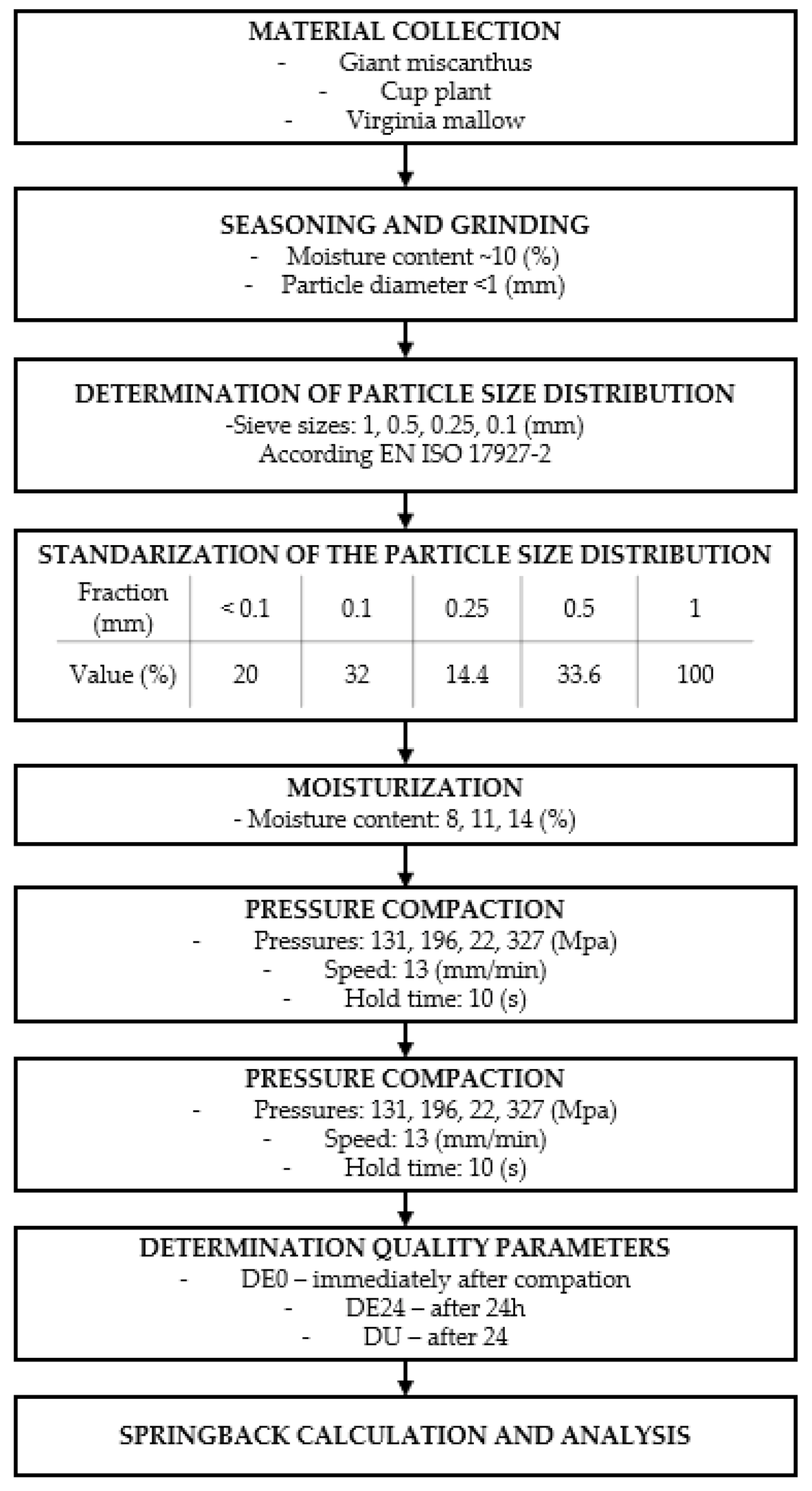
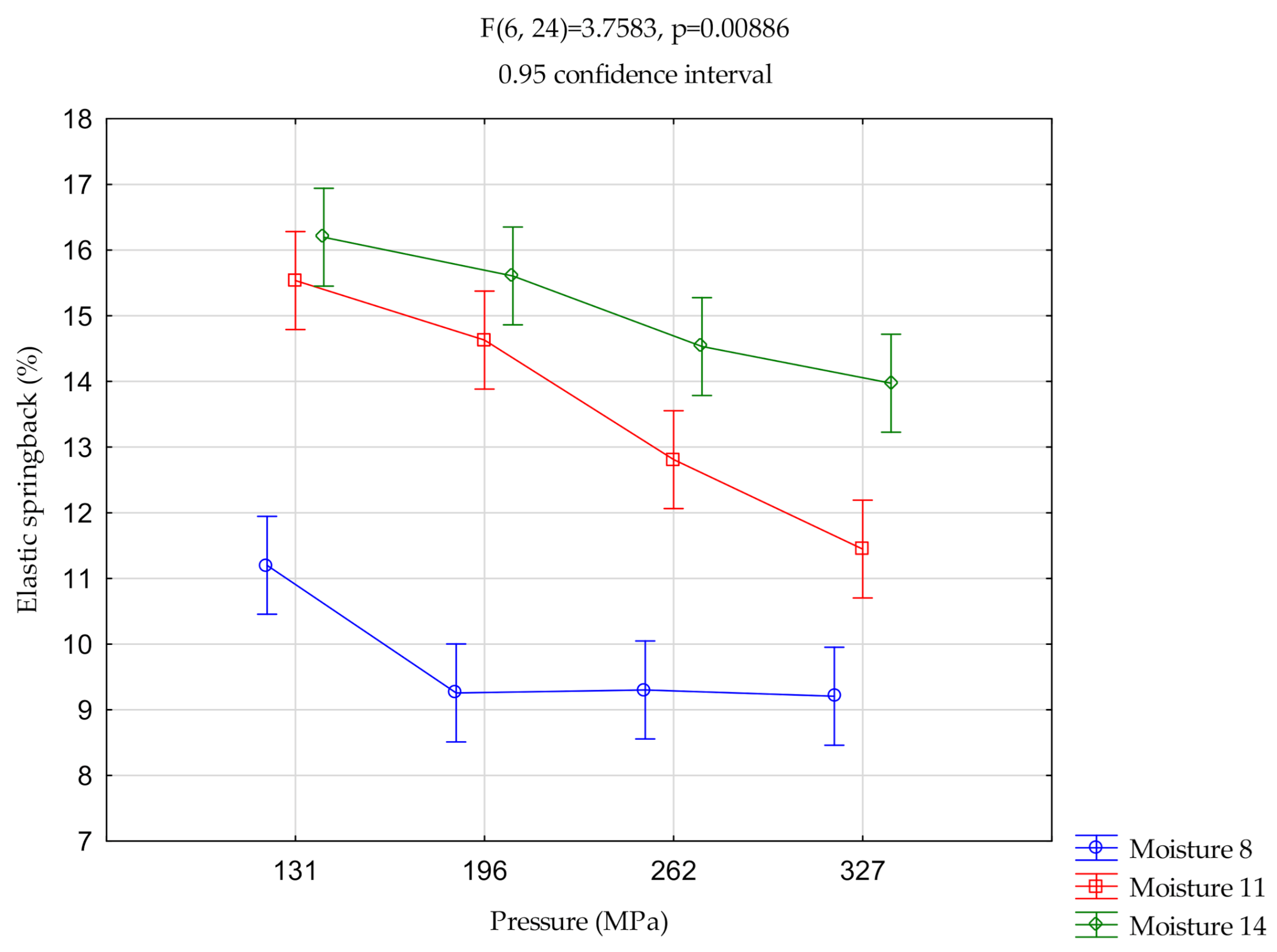
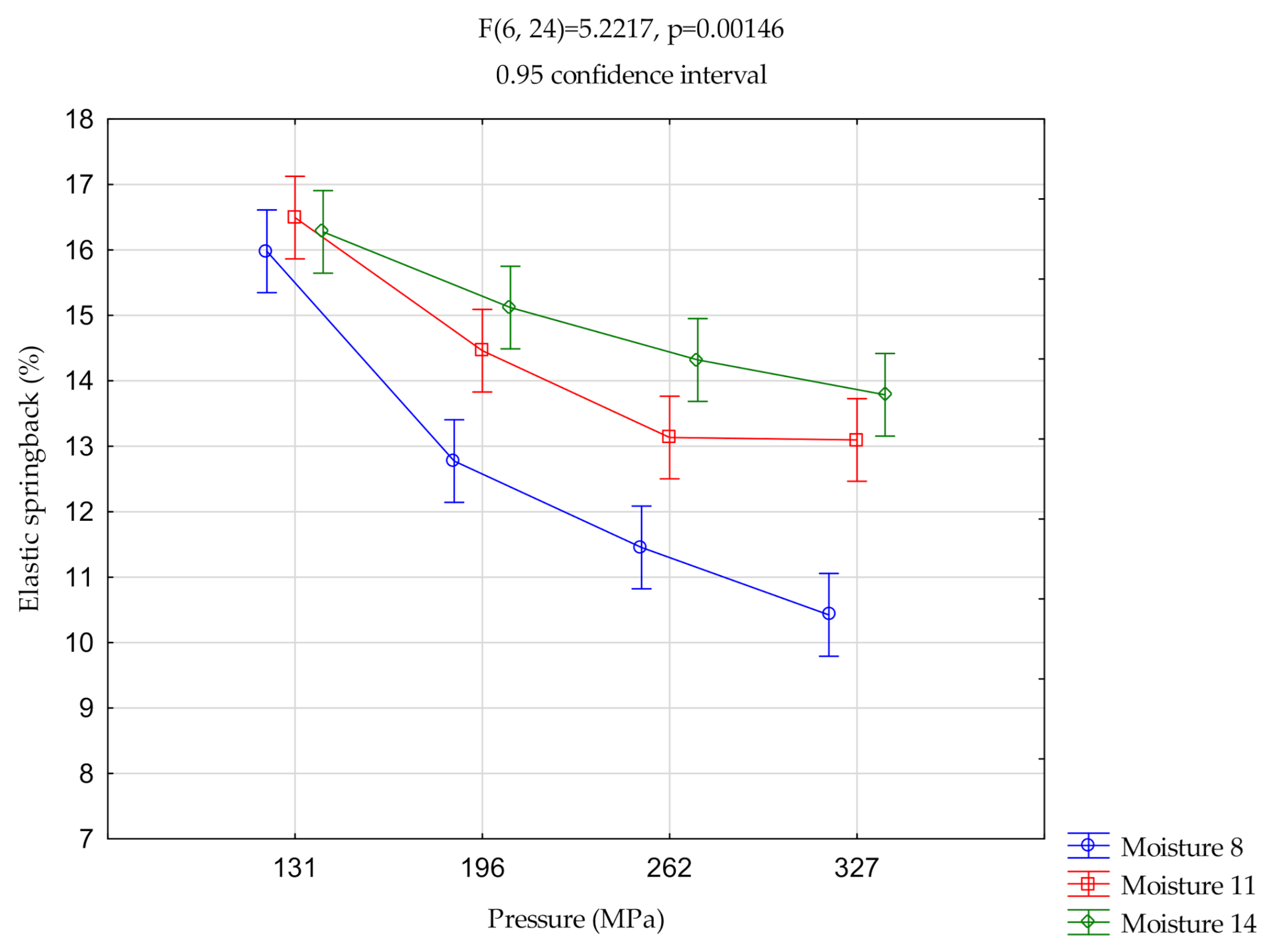
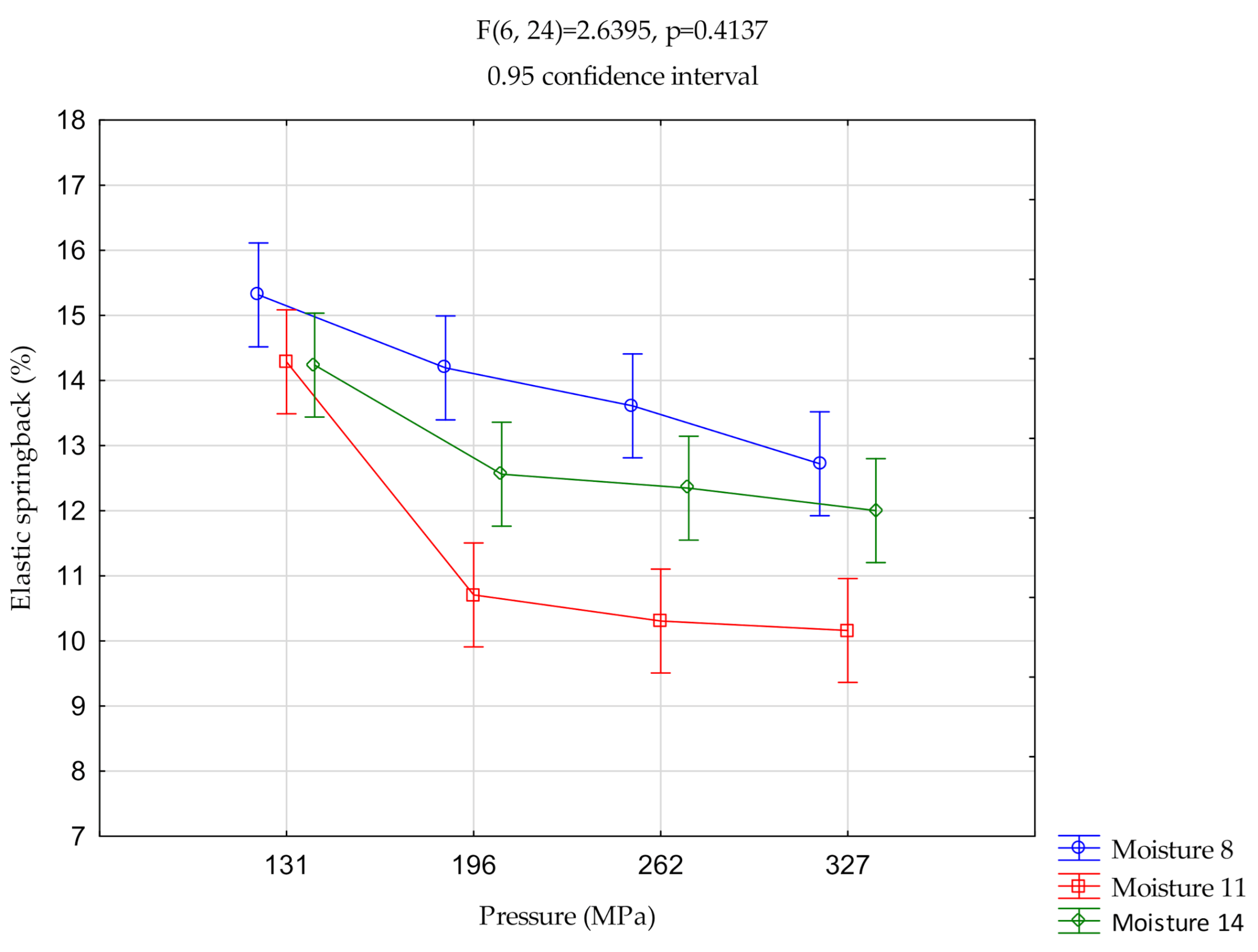
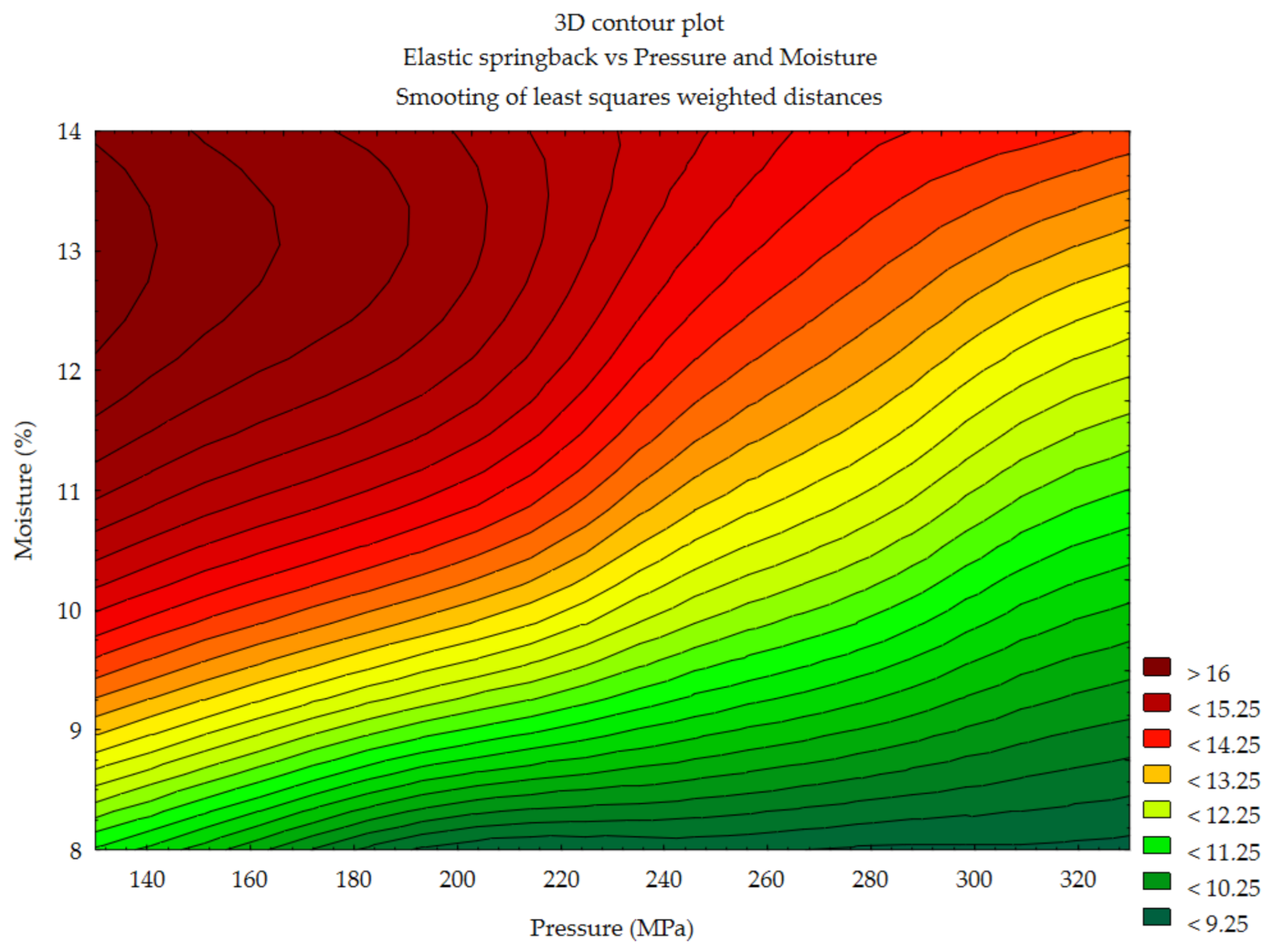
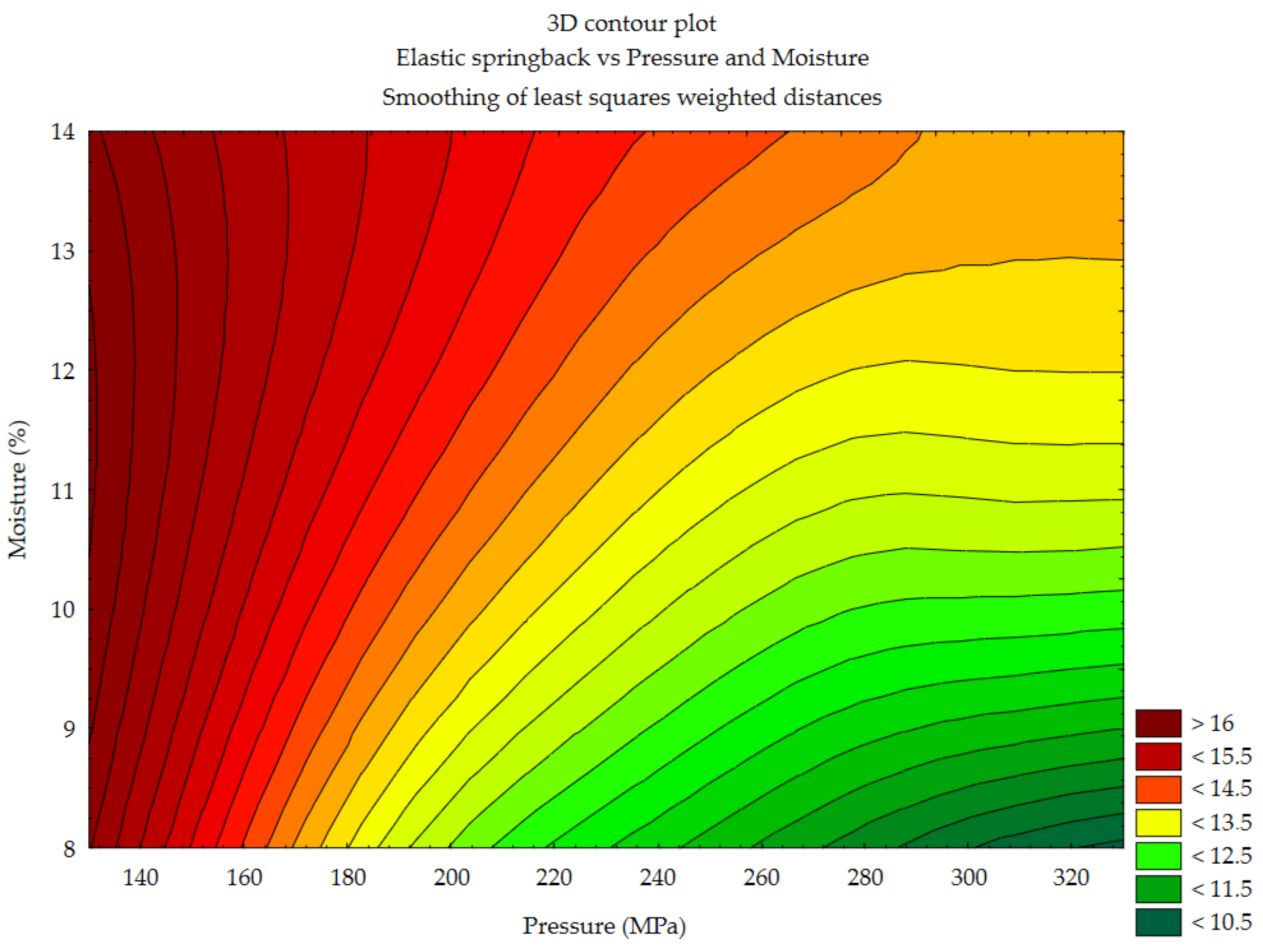
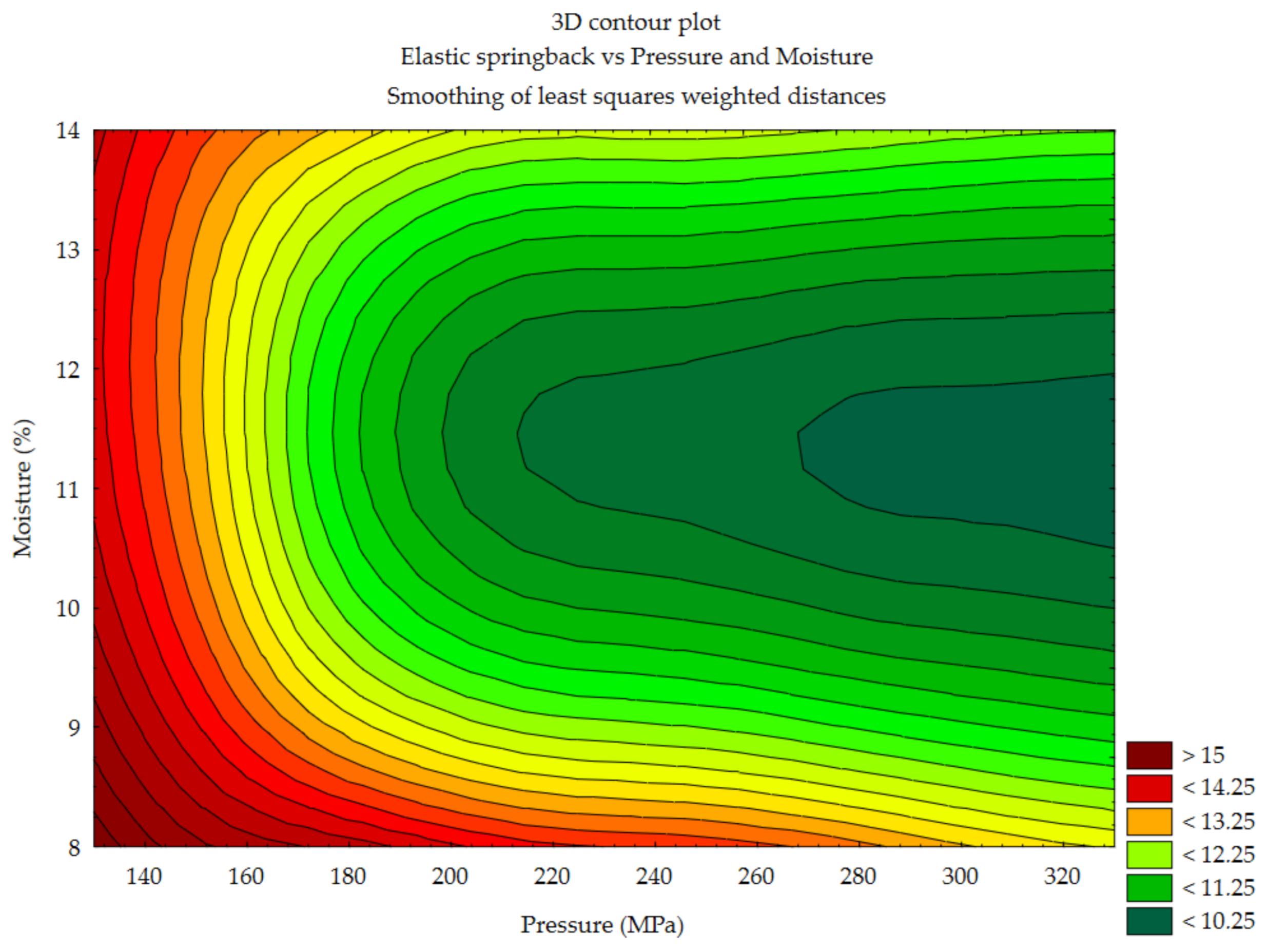
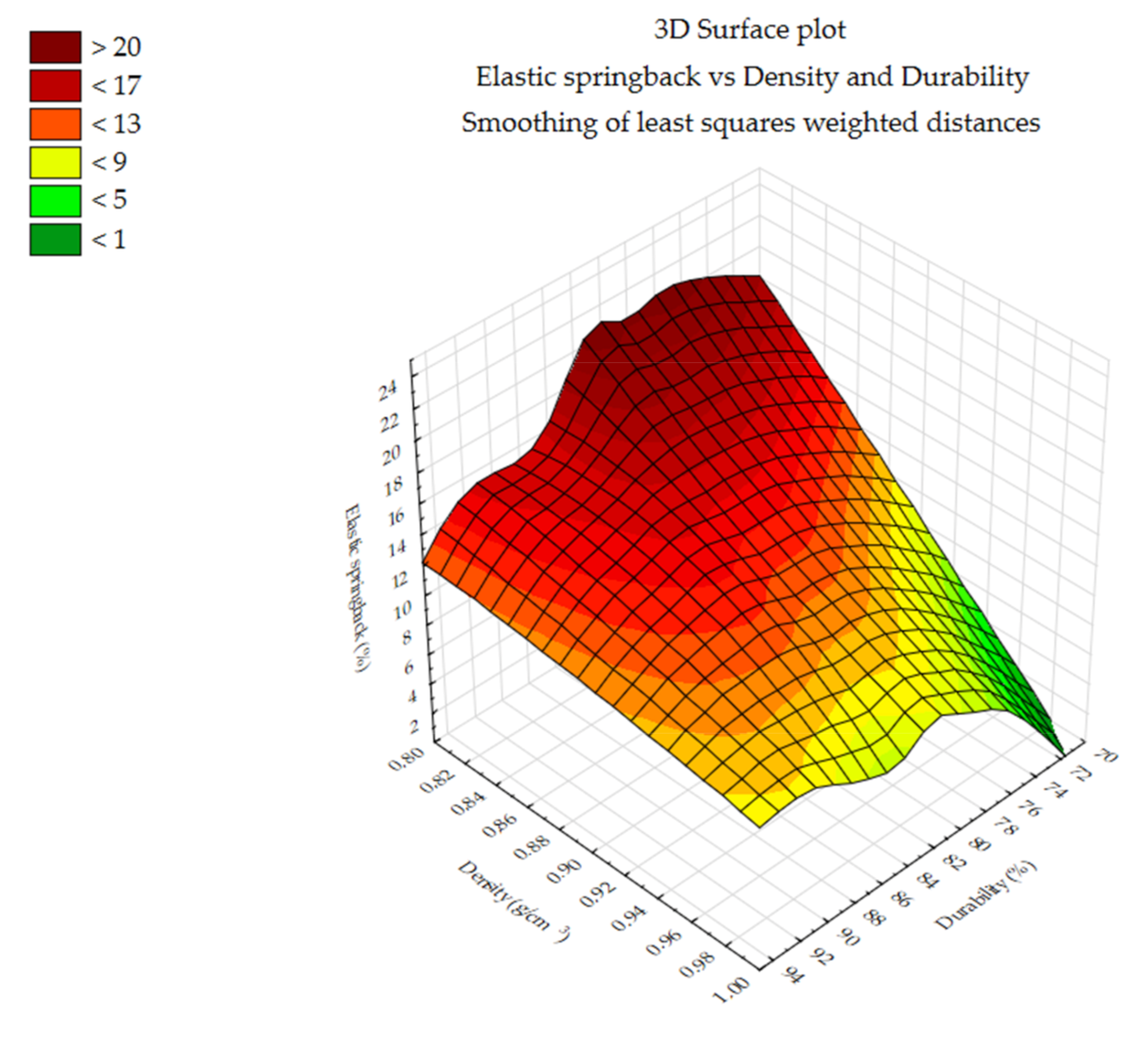
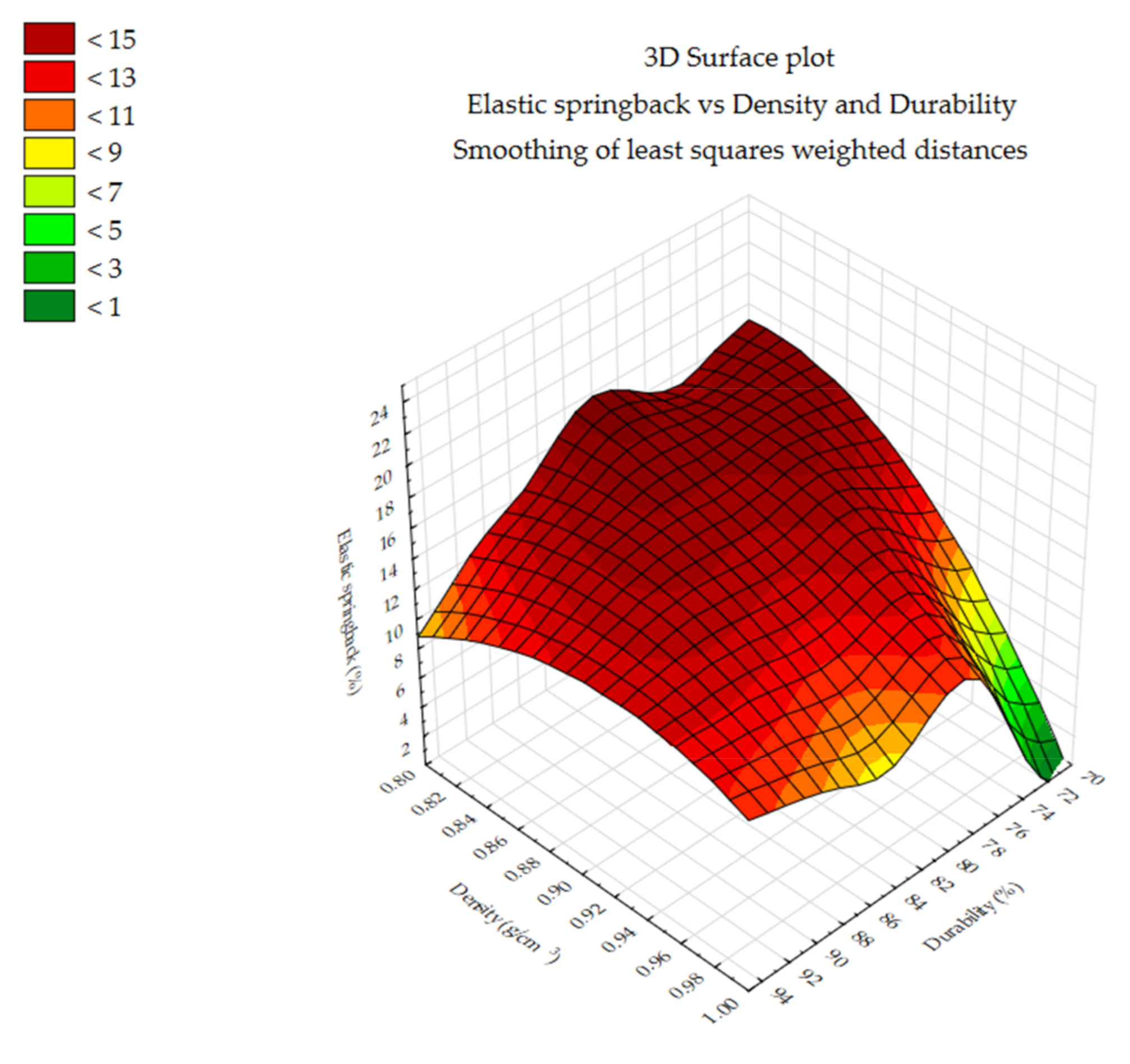
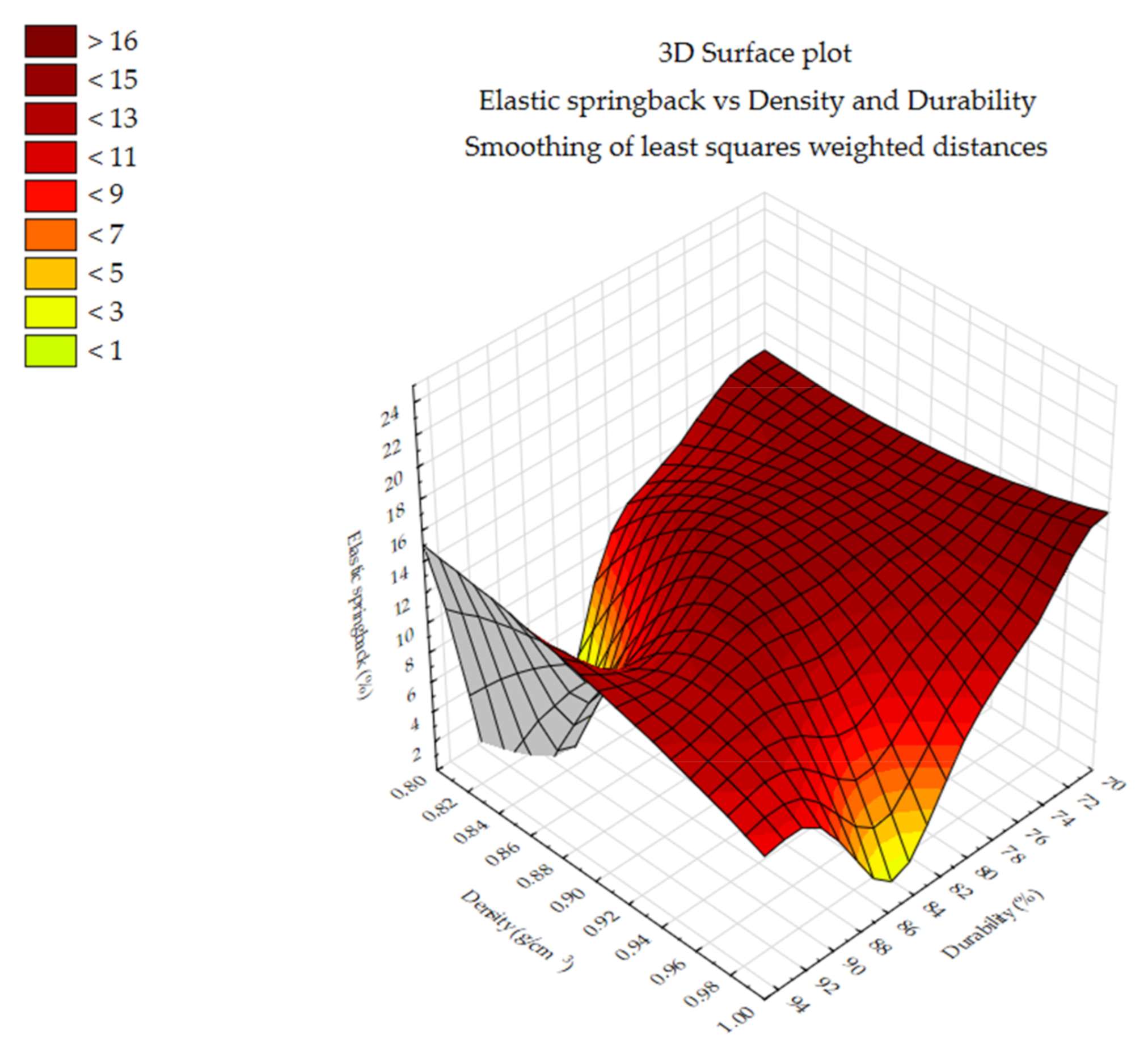
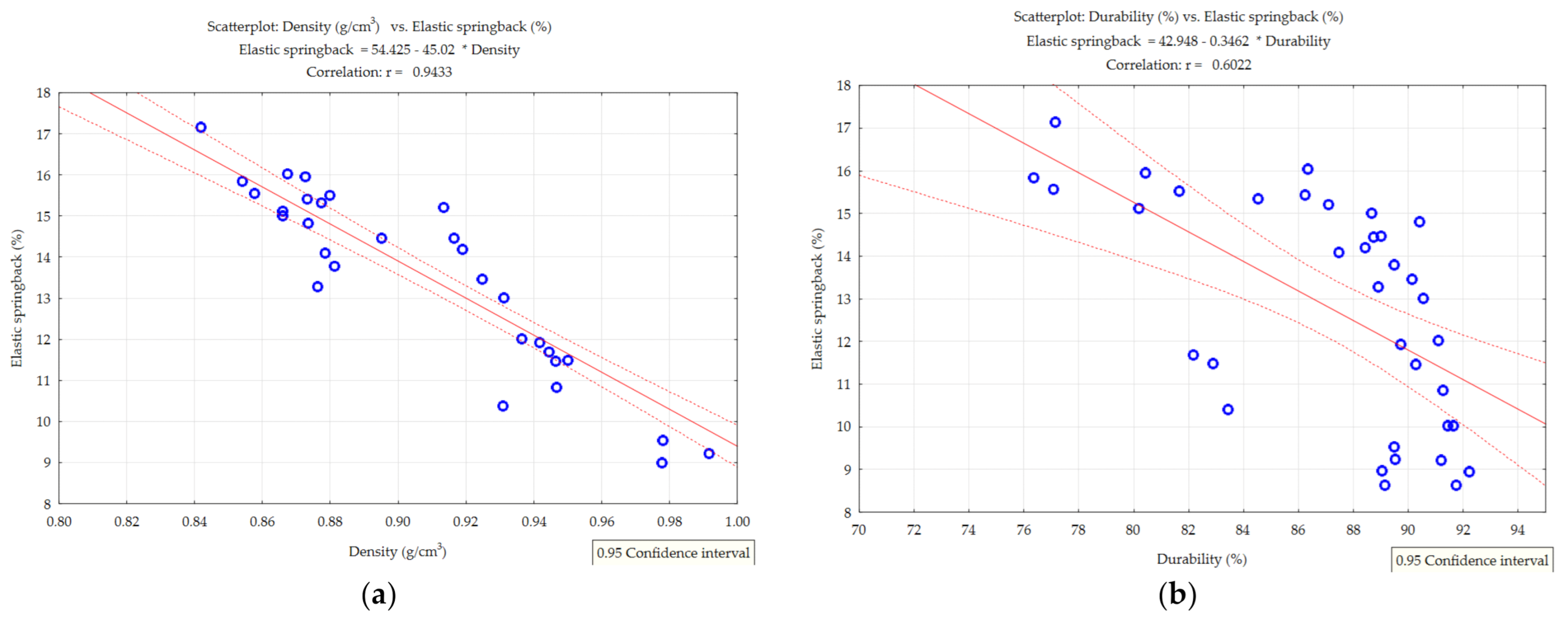
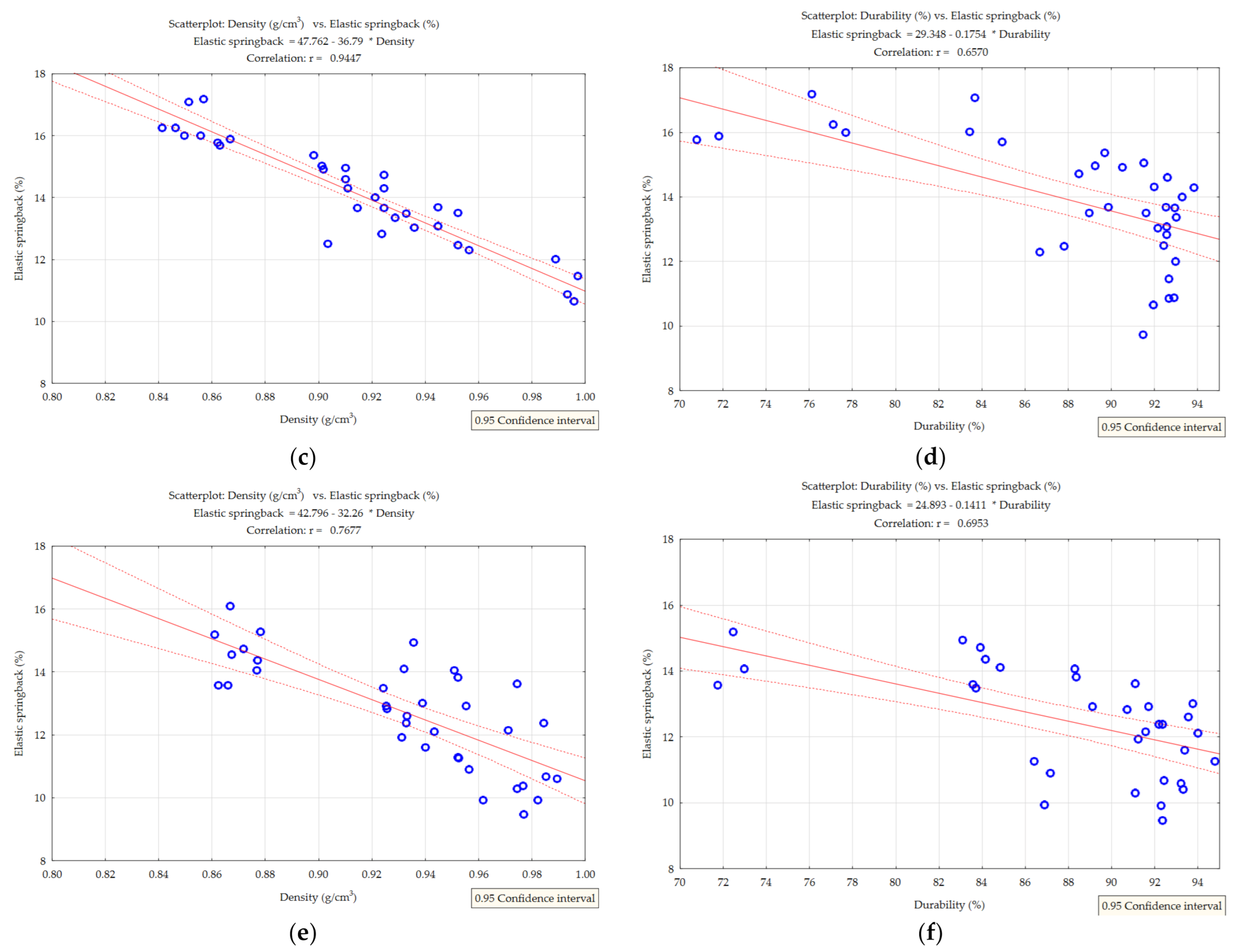
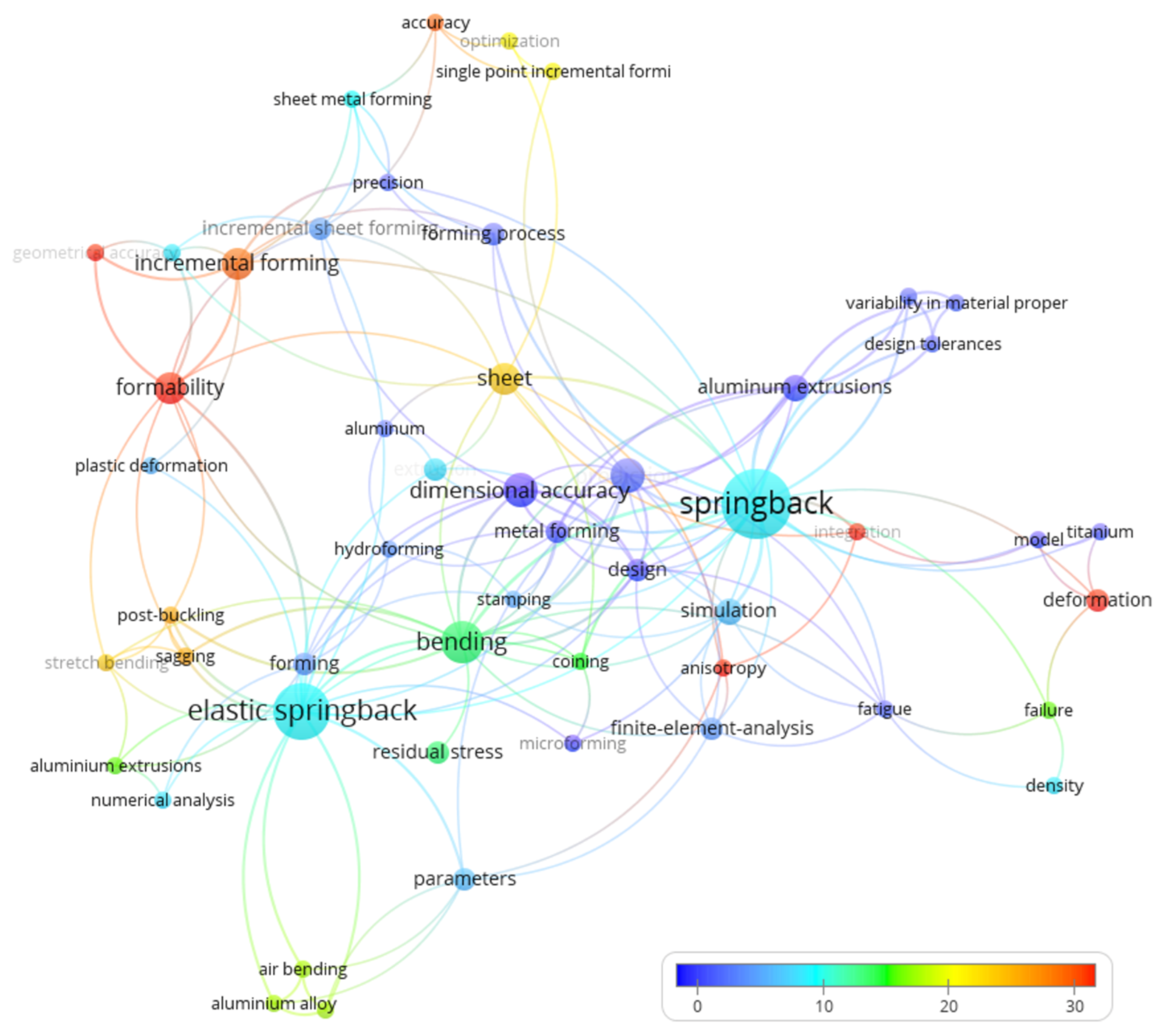
| SS | df | MS | F Value | p-Value | |
|---|---|---|---|---|---|
| Intercept | 5905.110 | 1 | 5905.110 | 15,096.26 | 0.000000 |
| Pressure | 39.057 | 3 | 13.019 | 33.28 | 0.000000 |
| Moisture | 182.245 | 2 | 91.123 | 232.95 | 0.000000 |
| Pressure × Moisture | 8.821 | 6 | 1.470 | 3.76 | 0.008861 |
| Error | 9.388 | 24 | 0.391 |
| SS | df | MS | F Value | p-Value | |
|---|---|---|---|---|---|
| Intercept | 6998.309 | 1 | 6998.309 | 24,931.12 | 0.000000 |
| Pressure | 77.152 | 3 | 25.717 | 91.62 | 0.000000 |
| Moisture | 31.750 | 2 | 15.875 | 56.55 | 0.000000 |
| Pressure × Moisture | 8.794 | 6 | 1.466 | 5.22 | 0.001455 |
| Error | 6.737 | 24 | 0.281 |
| SS | df | MS | F Value | p-Value | |
|---|---|---|---|---|---|
| Intercept | 5809.750 | 1 | 5809.750 | 12,955.44 | 0.000000 |
| Pressure | 47.081 | 3 | 15.694 | 35.00 | 0.000000 |
| Moisture | 40.533 | 2 | 20.266 | 45.19 | 0.000000 |
| Pressure × Moisture | 7.102 | 6 | 1.184 | 2.64 | 0.041374 |
| Error | 10.763 | 24 | 0.448 |
Publisher’s Note: MDPI stays neutral with regard to jurisdictional claims in published maps and institutional affiliations. |
© 2021 by the authors. Licensee MDPI, Basel, Switzerland. This article is an open access article distributed under the terms and conditions of the Creative Commons Attribution (CC BY) license (http://creativecommons.org/licenses/by/4.0/).
Share and Cite
Styks, J.; Knapczyk, A.; Łapczyńska-Kordon, B. Effect of Compaction Pressure and Moisture Content on Post-Agglomeration Elastic Springback of Pellets. Materials 2021, 14, 879. https://doi.org/10.3390/ma14040879
Styks J, Knapczyk A, Łapczyńska-Kordon B. Effect of Compaction Pressure and Moisture Content on Post-Agglomeration Elastic Springback of Pellets. Materials. 2021; 14(4):879. https://doi.org/10.3390/ma14040879
Chicago/Turabian StyleStyks, Jakub, Adrian Knapczyk, and Bogusława Łapczyńska-Kordon. 2021. "Effect of Compaction Pressure and Moisture Content on Post-Agglomeration Elastic Springback of Pellets" Materials 14, no. 4: 879. https://doi.org/10.3390/ma14040879
APA StyleStyks, J., Knapczyk, A., & Łapczyńska-Kordon, B. (2021). Effect of Compaction Pressure and Moisture Content on Post-Agglomeration Elastic Springback of Pellets. Materials, 14(4), 879. https://doi.org/10.3390/ma14040879






